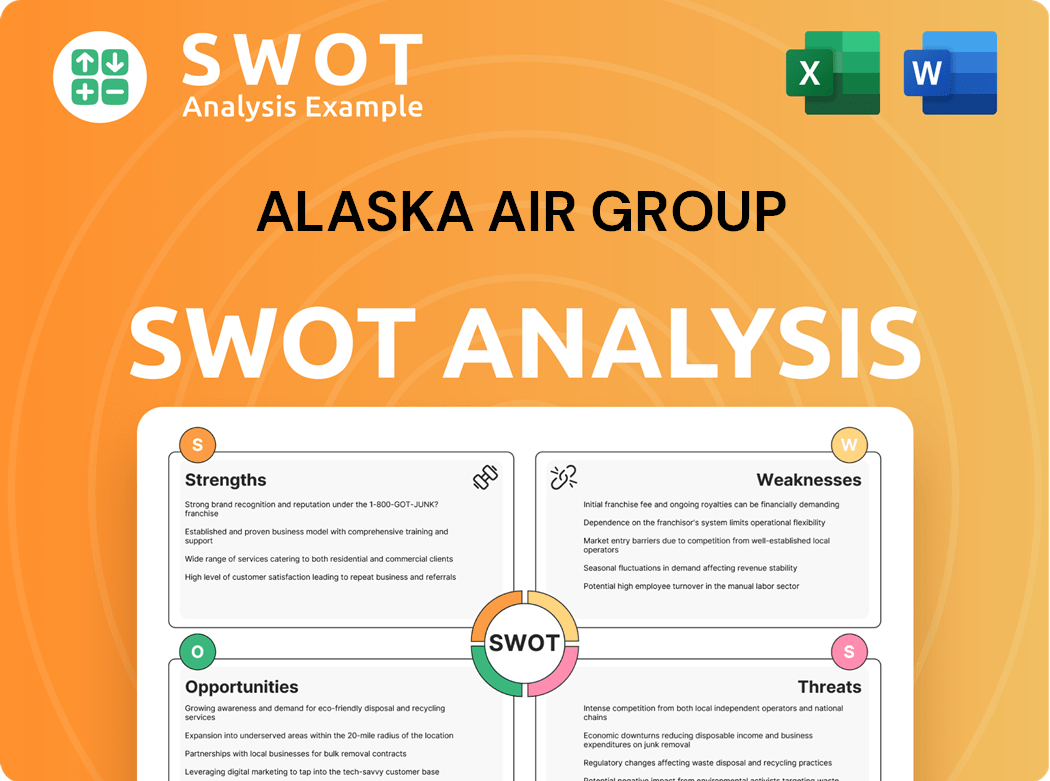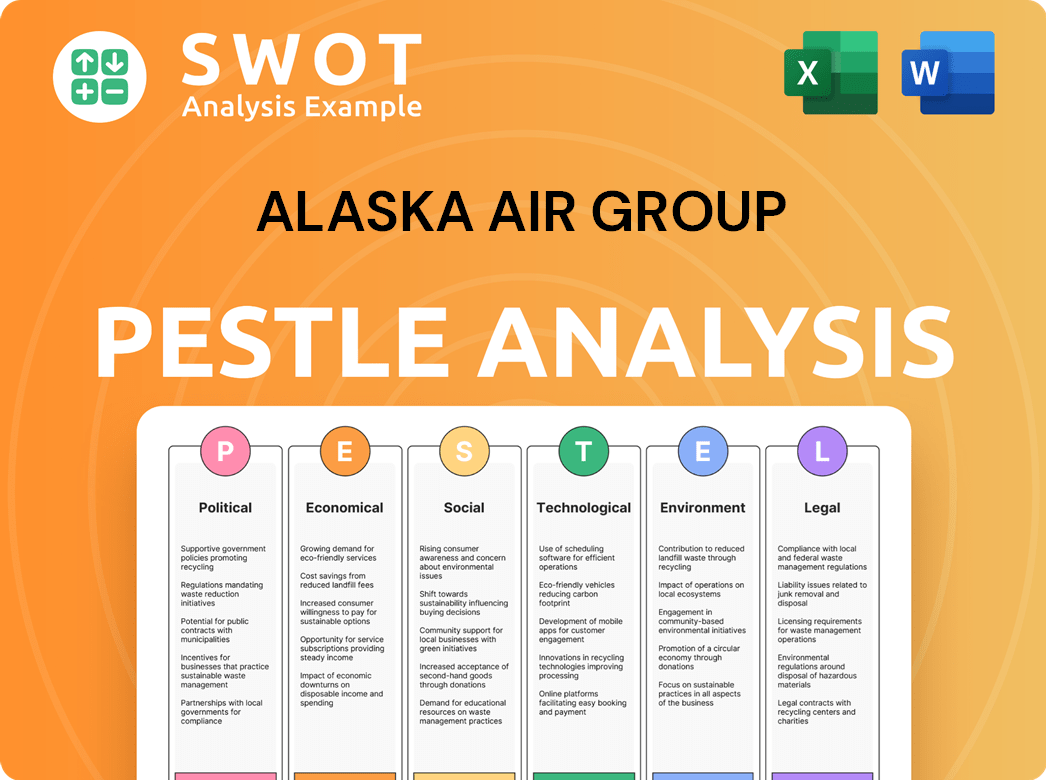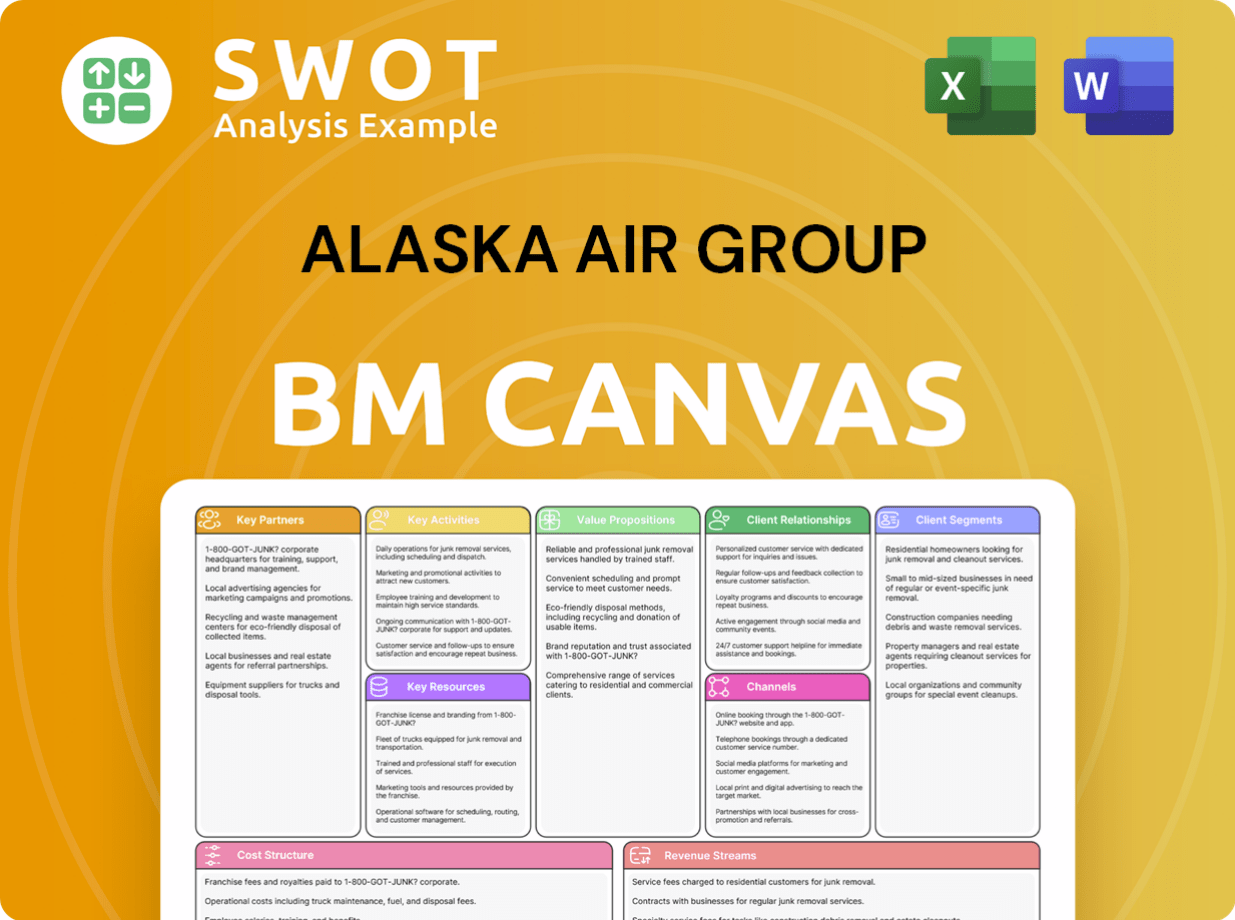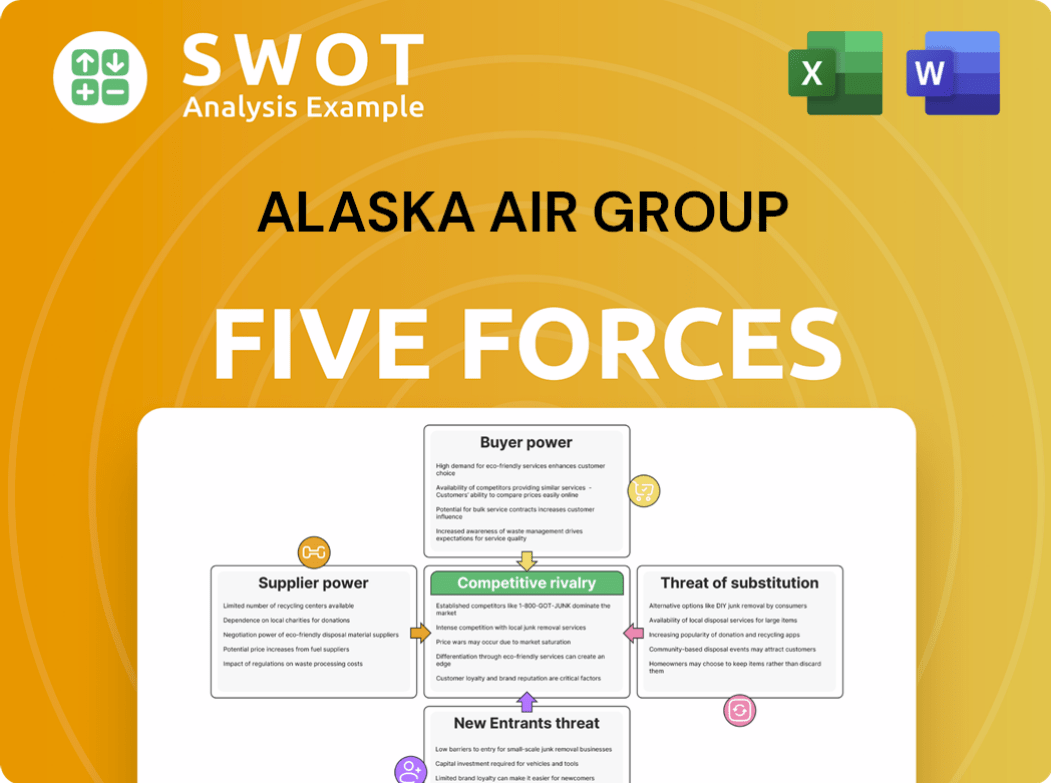Alaska Air Group Bundle
How did Alaska Air Group soar from Alaskan skies to become a North American airline giant?
Journey through the captivating Alaska Air Group SWOT Analysis and discover the remarkable transformation of Alaska Air Group, a company that began by navigating the unforgiving Alaskan wilderness. From its 1932 origins as McGee Airways, providing essential air services where ground travel was impossible, Alaska Airlines history is a testament to resilience and strategic vision. Witness how a small airline evolved into a major player in the airline industry.

This company profile delves into the brief history of Alaska Airlines, exploring key milestones, including the formation of Alaska Air Group in 1985, which fueled strategic acquisitions and growth. Learn about the early days of Alaska Air Group, its route expansion, and the significant events that shaped its journey. Understanding the Alaska Airlines founding date and subsequent evolution provides valuable insights into its current market position and future prospects within the aviation industry.
What is the Alaska Air Group Founding Story?
The story of Alaska Air Group, a prominent player in the airline industry, traces back to the challenging terrains of Alaska. Its origins are rooted in the vision of a pioneer who recognized the necessity of air transport in a region defined by its vast distances and difficult geography. This early chapter sets the stage for the evolution of what would become a significant force in aviation history.
The company's inception was marked by humble beginnings, but it quickly adapted to the unique demands of its environment. From charter flights to serving remote communities, the airline navigated financial hurdles and seasonal fluctuations. These early experiences shaped its resilience and laid the groundwork for its future expansion and success within the competitive aviation market.
The early financial challenges and strategic mergers highlight the dynamic nature of the airline's formative years. These pivotal moments, including acquisitions and name changes, were crucial in shaping its identity and setting the stage for its growth. These strategic moves were essential in building the foundation for the company's future.
The genesis of Alaska Air Group began on April 14, 1932, when Linious 'Mac' McGee and Harvey Barnhill established McGee Airways in Anchorage, Alaska. McGee, a pilot with a varied business background, saw the critical need for air transport in Alaska due to its difficult terrain. The company's initial operations were modest, starting with a single three-seat Stinson airplane.
- McGee Airways' primary function was charter flights.
- The airline transported both passengers and cargo, including liquor, to remote Alaskan communities.
- McGee took over sole ownership in 1932 and renamed the business McGee Airways.
- The difficult Alaskan economy and seasonal demand continuously presented financial challenges.
In 1934, McGee merged his airline with Star Air Service, an Anchorage-based operator that had a larger fleet. This merger created a more dominant airline in Alaska at the time. The combined entity still faced financial difficulties due to high operating costs. The company was incorporated as Star Air Lines in 1937.
- The merger with Star Air Service was a strategic move to consolidate resources and expand operations.
- Despite the merger, financial constraints persisted due to the high operational costs.
- Further acquisitions and name changes led to the company becoming Alaska Airlines in 1944.
- The evolution reflects the airline's adaptation and growth within the aviation market.
To understand the company's values, you can read more about the Mission, Vision & Core Values of Alaska Air Group.
Alaska Air Group SWOT Analysis
- Complete SWOT Breakdown
- Fully Customizable
- Editable in Excel & Word
- Professional Formatting
- Investor-Ready Format

What Drove the Early Growth of Alaska Air Group?
The early growth of Alaska Air Group, formerly known as Alaska Airlines, was marked by significant expansions following its establishment. Initially focused on cargo, the airline gradually incorporated passenger services, especially during the 1960s and 1970s. Deregulation in 1978 proved to be a turning point, allowing Alaska Airlines to broaden its reach beyond Alaska and into the continental United States.
Following deregulation, Alaska Airlines began expanding its route network. In 1979, it initiated services to Portland and San Francisco. By the early 1980s, the airline added several other West Coast cities to its destinations. This expansion was crucial for the airline's growth and market penetration.
To manage the expanding operations, Alaska Air Group was established as a holding company in 1985. This strategic move allowed for better organizational structure and management of the growing airline operations. The holding company structure facilitated further acquisitions and expansions.
A key acquisition in 1986 was regional airline Horizon Air, which significantly expanded the group's presence in the Pacific Northwest. The purchase of Jet America Airlines in 1987 further broadened its reach, although its operations were later integrated into Alaska Airlines. By the end of the 1980s, the airline served numerous cities outside of Alaska, with a substantial portion of its passengers traveling south of Seattle.
Passenger traffic increased significantly during the 1960s and 1970s, with the airline adapting its fleet to accommodate more travelers. The early fleet consisted of various aircraft, including the Douglas DC-6 and Boeing 727, which were essential for serving both cargo and passenger routes. By the late 1980s, the airline's fleet was modernized, reflecting its growth and expansion.
Alaska Air Group PESTLE Analysis
- Covers All 6 PESTLE Categories
- No Research Needed – Save Hours of Work
- Built by Experts, Trusted by Consultants
- Instant Download, Ready to Use
- 100% Editable, Fully Customizable

What are the key Milestones in Alaska Air Group history?
The Growth Strategy of Alaska Air Group has been marked by several significant milestones throughout its history, reflecting its growth and adaptation within the dynamic airline industry. These achievements highlight the company's evolution and strategic decisions over the years.
| Year | Milestone |
|---|---|
| 1989 | Became the first airline to use head-up guidance systems for operations in foggy conditions. |
| 1995 | Became the first U.S. carrier to sell tickets over the internet. |
| 2016 | Acquired Virgin America, significantly boosting its presence on the West Coast. |
| 2024 | Acquired Hawaiian Airlines, expanding its reach in Hawaii and the Pacific. |
Throughout its history, Alaska Airlines has been at the forefront of technological advancements and customer service enhancements. The company has consistently sought to integrate new technologies to improve operational efficiency and enhance the passenger experience.
Alaska Airlines was a pioneer in integrating GPS and Enhanced Ground Proximity Warning System (EGPWS) technology to enhance safety and navigation. This early adoption of advanced systems improved operational safety and efficiency.
As the first U.S. carrier to sell tickets over the internet in 1995, the airline revolutionized the way people booked flights. This innovation significantly improved customer convenience and streamlined the booking process.
The airline has continually invested in fleet modernization, including the introduction of fuel-efficient aircraft. This commitment to modernizing the fleet has reduced operational costs and environmental impact.
The airline has focused on improving the overall customer experience through initiatives such as in-flight entertainment and enhanced Wi-Fi. These improvements have increased customer satisfaction and loyalty.
Strategic partnerships and alliances have been key to expanding its network and providing more travel options for customers. These collaborations have allowed the airline to offer a broader range of destinations and services.
The airline has invested in sustainable aviation fuel (SAF) and other environmental initiatives to reduce its carbon footprint. These efforts demonstrate its commitment to environmental responsibility.
Despite its successes, Alaska Air Group has faced various challenges that have tested its resilience and strategic adaptability. These challenges have required the company to make strategic adjustments to maintain its competitive position.
Intense competition within the airline industry has consistently pressured profitability and market share. The airline has had to continually adapt to changing market conditions and consumer preferences.
The merger with Virgin America presented challenges in integrating different fleets, operational systems, and company cultures. Successfully integrating acquired airlines has been crucial for realizing the full benefits of these acquisitions.
The airline industry has faced macroeconomic factors and softening demand, impacting financial performance. The airline has had to adjust its strategies to manage economic uncertainties and demand fluctuations.
Operational challenges, such as aircraft groundings, have impacted the airline's performance and customer satisfaction. These disruptions have required the airline to implement robust contingency plans and improve operational resilience.
Rising fuel costs and inflationary pressures have increased operating expenses, impacting profitability. The airline has implemented strategies to manage these costs, including fuel hedging and operational efficiencies.
Negotiating and maintaining positive relationships with labor unions have been ongoing challenges. Successful labor relations are crucial for ensuring operational stability and employee satisfaction.
Alaska Air Group Business Model Canvas
- Complete 9-Block Business Model Canvas
- Effortlessly Communicate Your Business Strategy
- Investor-Ready BMC Format
- 100% Editable and Customizable
- Clear and Structured Layout

What is the Timeline of Key Events for Alaska Air Group?
The Alaska Airlines history is marked by significant milestones, beginning with its founding in 1932 by Linious 'Mac' McGee and Harvey Barnhill as McGee Airways in Anchorage, Alaska. The company evolved through mergers and expansions, officially becoming Alaska Airlines in 1944. The Airline Deregulation Act of 1978 opened doors for expansion, followed by the formation of Alaska Air Group in 1985 as a holding company. Acquisitions, including Horizon Air in 1986 and Jet America Airlines in 1987, expanded its reach. In 1995, Alaska Airlines pioneered online ticket sales. A major move was the 2016 acquisition of Virgin America, completed in 2018. Most recently, in September 2024, the company acquired Hawaiian Airlines, solidifying its market position and in 2024, it reported record revenues of $11.7 billion.
| Year | Key Event |
|---|---|
| 1932 | Linious 'Mac' McGee and Harvey Barnhill found McGee Airways in Anchorage, Alaska, marking the beginning of Alaska Airlines history. |
| 1934 | McGee Airways merges with Star Air Service. |
| 1944 | The company officially becomes Alaska Airlines. |
| 1978 | The Airline Deregulation Act allows for expansion beyond Alaska. |
| 1985 | Alaska Air Group is formed as a holding company. |
| 1986 | Acquires Horizon Air. |
| 1987 | Acquires Jet America Airlines. |
| 1995 | Becomes the first U.S. carrier to sell tickets over the internet. |
| 2016 | Acquires Virgin America. |
| 2018 | Virgin America brand is fully retired. |
| 2024 | Acquires Hawaiian Airlines in September. |
| 2024 | Reports record revenues of $11.7 billion. |
Looking towards 2025, the airline plans to launch new nonstop flights from Seattle to Tokyo Narita and Seoul Incheon, broadening its international reach. The company projects earnings per share (EPS) in excess of $5.75. These strategic moves underscore the company's commitment to expanding its global footprint and enhancing its service offerings.
By 2027, the company aims to achieve $1 billion in incremental pretax profit with pretax margins ranging from 11% to 13%. A key initiative is the 'Alaska Accelerate' strategic plan, which includes a $1 billion share repurchase program, reflecting confidence in its financial outlook. The company is focused on profitable growth and operational efficiency.
By 2030, the airline aims to serve 12 international widebody destinations from its Seattle gateway, further establishing its presence in the global market. This expansion is part of a broader strategy to enhance its network and provide more travel options. To understand more about the company's financial aspects, read the Revenue Streams & Business Model of Alaska Air Group.
The company faces potential headwinds from economic uncertainty and the complexities of integrating new acquisitions. Despite these challenges, the airline remains focused on customer loyalty and building on its vision of connecting communities through air travel. The company's success depends on its ability to adapt to market changes.
Alaska Air Group Porter's Five Forces Analysis
- Covers All 5 Competitive Forces in Detail
- Structured for Consultants, Students, and Founders
- 100% Editable in Microsoft Word & Excel
- Instant Digital Download – Use Immediately
- Compatible with Mac & PC – Fully Unlocked

Related Blogs
- What is Competitive Landscape of Alaska Air Group Company?
- What is Growth Strategy and Future Prospects of Alaska Air Group Company?
- How Does Alaska Air Group Company Work?
- What is Sales and Marketing Strategy of Alaska Air Group Company?
- What is Brief History of Alaska Air Group Company?
- Who Owns Alaska Air Group Company?
- What is Customer Demographics and Target Market of Alaska Air Group Company?
Disclaimer
All information, articles, and product details provided on this website are for general informational and educational purposes only. We do not claim any ownership over, nor do we intend to infringe upon, any trademarks, copyrights, logos, brand names, or other intellectual property mentioned or depicted on this site. Such intellectual property remains the property of its respective owners, and any references here are made solely for identification or informational purposes, without implying any affiliation, endorsement, or partnership.
We make no representations or warranties, express or implied, regarding the accuracy, completeness, or suitability of any content or products presented. Nothing on this website should be construed as legal, tax, investment, financial, medical, or other professional advice. In addition, no part of this site—including articles or product references—constitutes a solicitation, recommendation, endorsement, advertisement, or offer to buy or sell any securities, franchises, or other financial instruments, particularly in jurisdictions where such activity would be unlawful.
All content is of a general nature and may not address the specific circumstances of any individual or entity. It is not a substitute for professional advice or services. Any actions you take based on the information provided here are strictly at your own risk. You accept full responsibility for any decisions or outcomes arising from your use of this website and agree to release us from any liability in connection with your use of, or reliance upon, the content or products found herein.